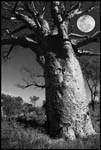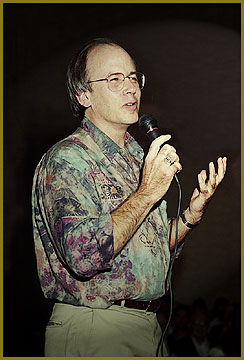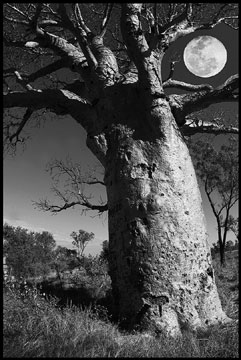|
|
Essay #010"A Comment on Image Manipulation " |
|
Jay Goodrich of Vail, CO writes on NANPA's Ethics web page: 'If you sit down and really think about it, the artist (photographer) shows you what he or she wants you to see, whether it be manipulated or not. It is all art and the beauty is in the eye of the beholder. We should not think of an image as real or not, but rather as an image that captures a place in our hearts, our minds, and our souls.' (see NANPA website: www.nanpa.org) I second that motion! Why folks worry so much about image manipulation I don't know. Every aspect of photography is representational at best. In nature photography, for example, we have already 'disturbed' a scene by virtue of our presence in it. By walking in or on fragile ecosystems, like barrier reefs or tidal pools, we are irreversibly changing those ecosystems by our very footprints. Sometimes a mere footprint can destroy whole ecosystems! When we camp somewhere we leave our tent's imprint behind, plus we leave behind human smells, debris probably, and certainly a wildlife population which has had to distance itself from us for safety while we were working in their habitat. How many wildlife babies were put at risk unknowingly by us when their parents fled the scene in order to draw attention away from them? All that happens to c-h-a-n-g-e the scene before we even press the shutter button. Indeed, the very act of capturing a scene on film (or on smartcards now) captures a mere moment in time, a nanosecond of perception that first had to be filtered through the eyes of the photographer-observer whose own biases, knowledge-base, and philosophy of life impinged on it. The decision to 'tell a story' by a our photograph is a decision to manipulate it. We show this or that, we deliberately don't show that, we employ filters and other image enhancements in the field in order to tell the story as we perceive it to be. We deliberately manage the scene in many ways for the sake of our story. This is image manipulation. And that's ok by me. Thanks to Adobe's Photoshop software we now have available to us a fantastically rich archive of artistic resources to manage our photographs in better and more sophisticated ways than anything we can possibly do in the field. The field work just gets us the basic blueprint these days - we can actually shoot now on dark and dreary days, at high noon if we have to, in fields of debris or wherever our 'story' happens to be, we can shoot even in extremely low-light conditions.....yes, we can tell the story better now because we can enhance with elements that bring the scene or subject closer to what it look likes under a variety of climate or other conditions.
Take this image I shot of Dewitt Jones at the '95 Summit in Ft. Meyers: I removed glaring ceiling lights, overhead wires and other debris from the auditorium where he was talking to us about 'juice cameras.' I also added some directional lighting to spotlight him because the facility we were meeting in didn't have that kind of equipment for our use. The other thing I did was to remove the refractive glare from Dewitt's eye glasses...otherwise what you see is what I got when I hugged Dewitt with my eyes and 'captured' him. His essence is unchanged. The image concentrates our focus on Dewitt and not on the unfortunate conference environment that surrounded him. We do the same things with our nature photographs except that our subjects aren't always so wild and delectable as Dewitt.
The shot of the Boab tree is a 1,000 year old specimen that I saw while traveling in remote Western Australia. I stood close to the tree and shot it with a 16mm f2.8 fisheye lens that I carefully held in order to control some of the distortion inherent to that lens. I needed the 16mm to get the whole subject into the shot. I was there at dusk and the moon was out but you know how impossible it is to shoot a scene like this with the moon in it. The moon was full and low in the sky and what you see in the shot is how the moon actually looked at the time....BUT...how did I manage it? I set aside my F5 and put a 600mm f4 lens on my Nikon D1 digital body which effectively gave the lens a 900mm reach! I shot only the moon in that frame. Later I composited the two images taken with different lenses and different camera systems and ended up with an image that represents, to the best of my ability, how that magical scene actually looked. The output is in grayscale to give an even more realistic impression of how the fading light transfixed the moment. There is a huge difference between documentary photography and photography as art. Documentary photography has to be untouched or else it is no longer 'documentary.' These are the kinds of images you mostly see in textbooks whose primary mission is to teach. Nature photography can certainly be 'documentary' in nature but it doesn't have to be. Take zoos - I am not a particular fan of most zoos because I am a long-time wildlife activist and I hate to see animals in captivity, especially in seriously deficient captive environments. But I also understand that the future of some species rests on captive breeding programs in top-ranked zoo environments. I also know that most humans will never see in person the magical species that you and I are often privileged to shoot in the wilds of South America, Africa, Australia and elsewhere. Zoo photographs can be very boring photographs simply because the animal is in captivity. Captivity changes many things about them including posturing and responsiveness to their environment, not to mention the fact that their essence is often clouded by boredom which is not something that comes through in the wild. A great many photographers out there, unfortunately, are skilled technicians who know how to take a good photograph, however they do NOT know their subjects well and their images almost always reveal this. It is not enough just to know a species' scientific name. In order to do justice to a subject you need to know much more about the subject's habitat of choice, its place in the predatory hierarchy, its typical habits and behaviors under a variety of conditions in the wild. Those who try to present a zoo animal as a non-captive specimen are only fooling themselves (and some publishers, maybe). Those of us with biological, zoological or natural history backgrounds are always going to be able to tell the difference. And for us, well, image honesty is clearly in the eyes of the beholder. Our photos really only tell part of the story anyway. You can look at a hundred Frans Lanting photographs of charging African elephants and still you will be so much less moved by the experience than if you were to able to reach out and touch, smell, hear, and see one of those magical giants upclose. The truth is, in our urban world the zoos have to do some of the necessary conservation and education for us, beyond what our cameras can offer up. We as nature photographers have a responsibility to help bring the natural world into closer contact with the lives of humans everywhere on this planet. It is a responsibility that we shouldn't take lightly. Our work is urgently needed. We all know that even Ansel Adams used his darkroom to help him tell a better 'story' whenever possible. Our darkrooms today just happen to be digital darkrooms. And lucky for us, eh!? Art Wolfe's 'zebra' problem was too funny. I remember him telling us about that quandary at one of the NANPA Summits and I have to tell you, that guy places himself in harms way all the time in order to touch our hearts and our minds with his mesmerizing images of the natural world. If his artistry requires him to add some stripes to that running herd of Zebra's I say GO FOR IT. He is an artist, after all, and I happen to love him for it. Ellen |
|
|
| © 2002 Dr. Ellen K.Rudolph |
| drellenr@aol.com
www.drellenrudolph.com |
| Here is a news group for discussing the Outback Photo Essays. |
|
|
| For Comments post in our News Group |







